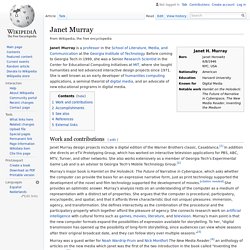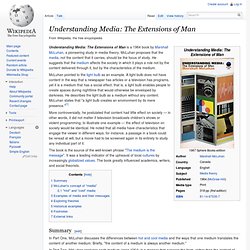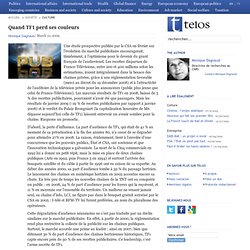

What's new media? New media studies - Wikipedia, the free encyclopedia - Mozilla F. Janet Murray. Janet Murray is a professor in the School of Literature, Media, and Communication at the Georgia Institute of Technology.

Before coming to Georgia Tech in 1999, she was a Senior Research Scientist in the Center for Educational Computing Initiatives at MIT, where she taught humanities and led advanced interactive design projects since 1971. She is well known as an early developer of humanities computing applications, a seminal theorist of digital media, and an advocate of new educational programs in digital media. Work and contributions[edit] Janet Murray design projects include a digital edition of the Warner Brothers classic, Casablanca.[1] In addition she directs an eTV Prototyping Group, which has worked on interactive television applications for PBS, ABC, MTV, Turner, and other networks.
She also works extensively as a member of Georgia Tech's Experimental Game Lab and is an advisor to Georgia Tech's Mobile Technology Group.[2] Accomplishments[edit] See also[edit] References[edit] Marshall McLuhan. Understanding Media: The Extensions of Man - Wikipedia, the free. McLuhan pointed to the light bulb as an example.

A light bulb does not have content in the way that a newspaper has articles or a television has programs, yet it is a medium that has a social effect; that is, a light bulb enables people to create spaces during nighttime that would otherwise be enveloped by darkness. He describes the light bulb as a medium without any content. McLuhan states that "a light bulb creates an environment by its mere presence. "[1] More controversially, he postulated that content had little effect on society — in other words, it did not matter if television broadcasts children's shows or violent programming, to illustrate one example — the effect of television on society would be identical.
The book is the source of the well-known phrase "The medium is the message". Summary[edit] In Part One, McLuhan discusses the differences between hot and cool media and the ways that one medium translates the content of another medium. Quand TF1 perd ses couleurs. Une étude prospective publiée par le CSA en février sur l’évolution du marché publicitaire encouragerait, timidement, à l’optimisme pour le devenir du géant français de l’audiovisuel.

Les recettes disparues de France-Télévisions, entre 200 et 400 millions selon les estimations, iraient intégralement dans la besace des chaînes privées, grâce à une réglementation favorable (merci au décret du 19 décembre 2008) et à l’attractivité de l’auditoire de la télévision privée pour les annonceurs (public plus jeune que celui de France-Télévisions). Les mauvais résultats de TF1 en 2008, baisse de 3 % des recettes publicitaires, pourraient n’avoir été que passagers.
Mais les résultats de janvier 2009 (-19 % de recettes publicitaires par rapport à janvier 2008) et le verdict du Palais Brongniart (la capitalisation boursière de M6 dépasse aujourd’hui celle de TF1) laissent entrevoir un avenir sombre pour la chaîne. Risquons un pronostic. D’abord, la perte d’influence. Secrète, mais fragile. . © Telos. Le futur du Web Social selon Forrester.
Aujourd'hui le moins que l'on puisse dire, c'est que l'expérience sociale sur le web est pour l'utilisateur un joyeux bazar à peine défriché où chaque visite sur un nouveau site impose la création d'un nouveau profil et la dilution de l'identité de chacun.

Pour mémoire, les réseaux sociaux attirent désormais 22,5 des 34 millions d’internautes français parmi lesquels 22 millions de cyberacheteurs, pour environ 1 h 40 mn de surf mensuel. Fin avril, Forrester, sous la signature de Jeremiah Owyang a publié une étude "Future of the Social Web". A la fois courageuse, puisqu'elle propose une vision à 5 ans - malgré le fait qu'aucun des responsables des 24 entreprises interrogées dont Dell, Google, Facebook n'ait voulu/pu se projeter dans 5 ans ; et dérangeante parce qu'en examinant les changements radicaux qu'a provoqué et provoque encore le web social, Owyang n'annonce pas que du bon.
Si vous êtes une marque, prenez rapidement le train des réseaux sociaux, sous peine de rester sur le quai. Social construction of technology - Wikipedia, the free encyclop. Social construction of technology (also referred to as SCOT) is a theory within the field of Science and Technology Studies.

Advocates of SCOT—that is, social constructivists—argue that technology does not determine human action, but that rather, human action shapes technology. They also argue that the ways a technology is used cannot be understood without understanding how that technology is embedded in its social context. SCOT is a response to technological determinism and is sometimes known as technological constructivism. SCOT draws on work done in the constructivist school of the sociology of scientific knowledge, and its subtopics include actor-network theory (a branch of the sociology of science and technology) and historical analysis of sociotechnical systems, such as the work of historian Thomas P. Hughes.
SCOT holds that those who seek to understand the reasons for acceptance or rejection of a technology should look to the social world. Symmetry[edit] Core concepts[edit] Out of print.